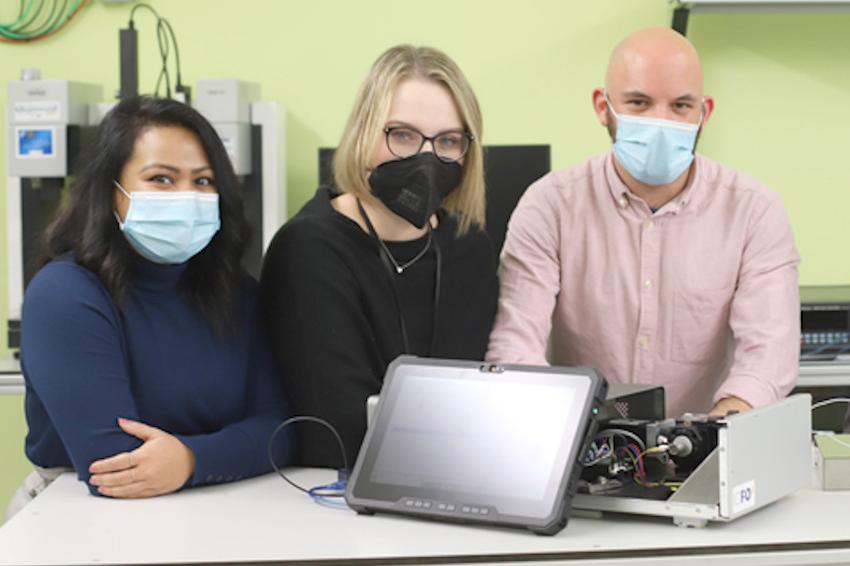Photonic saliva test for COVID-19
Portable instrument combines fluorescence reader and microfluidic chip
Researchers from ICFO-The Institute of Photonic Sciences and IrsiCaixa AIDS Research Institute, both in Spain, have demonstrated a new low-cost portable instrument that manipulates light and fluid for fast and reliable detection of SARS-CoV-2 in saliva samples. Although still in the research stage, the new device could offer a higher sensitivity than today’s COVID-19 rapid antigen tests while also being faster and more cost-effective than PCR tests.
“Our instrument, which requires just a few drops of saliva, would be useful for mass screening in settings such as restaurants, schools, offices, theatres and cinemas,” said researcher Alfredo Ongaro from ICFO. “What’s more, the technology can be easily adapted to detect markers for other pathogens, including those that may be involved in future outbreaks.” Now, the researchers report that the system correctly detected 91.2 % of COVID-19 positive cases and 90 % of negative cases in tests of more than 50 previously frozen saliva samples. The test can measure very small quantities of virus like PCR tests but is as fast as rapid antigen tests.
The new instrument, which the researchers call a flow virometry reader, is based on a modification of flow cytometry, a laser-based technique that uses fluorescence to count or analyze cells. Rather than counting cells, the new device detects light emission from fluorescent antibodies that bind to specific viral particles. It can offer quantitative results in less than 30 minutes using an instrument that is about the size of a shoebox. “Due to its low cost and simple design, the flow virometry reader could be particularly useful for low-income countries with limited access to healthcare,” said Ongaro. Also, non-specialist users can easily operate the device, and testing can be carried out anywhere since no specialized laboratory is required, explained Marisa Rodriguez and Jorge Carrillo, researchers from IrsiCaixa AIDS Research Institute.
The new instrument was developed as a collaboration between the ICFO optoelectronics group led by Valerio Pruneri and IrsiCaixa AIDS Research Institute, a center specializing in infectious diseases. “The flow virometry reader we developed at ICFO, together with IrsiCaixa’s methodology for detecting viruses in saliva, creates a reliable and feasible alternative technique to existing tests,” said Rubaiya Hussain, a researcher at ICFO. “The reader can be easily built with commercially available components and allows up to 2,000 tests per day to be performed using a single device.”
To run a test, a saliva sample is introduced in a solution that contains fluorescent antibodies that will attach to SARS-CoV-2 particles. The sample is then processed by the flow virometry reader, which uses a single microfluidic channel to pass the sample through a laser illumination and detection setup. If viral particles are present in the solution, they change the sample’s fluorescence in a detectable way, providing information that can be used to calculate the viral concentration.
The researchers calibrated the new instrument by determining its detection limits using a set of prepared saliva samples containing a known amount of virus. “We obtained an outstanding result of detecting 3,834 viral copies per milliliter,” said Ewelina Wajs, a researcher at ICFO. “This is at least three orders of magnitude lower than that of commercially available rapid antigen tests, which shows that our device can detect the presence of virus in very low concentration samples.”
They then evaluated the performance of the system for detecting SARS-CoV-2 in clinical samples. For this, they conducted a blind test of frozen saliva samples from more than 50 COVID-19 positive and uninfected individuals. The instrument reliably detected 31 out of 34 COVID-19 positive patient samples and 18 out of 20 SARS-CoV-2 negative samples, which had been previously analyzed using PCR testing. While the proposed technology has the potential to replace or complement PCR tests, more experiments are necessary to clinically assess the similarity of the two methods.
The researchers are now working to develop an integrated flow virometry reader for simultaneous SARS-CoV-2 antigen and antibody analysis. Such a testing device could identify active infections as well as provide information on the immune response to a previous infection or vaccination. This will allow fast checking of vaccine efficiency and help to determine whether additional vaccination boosters are needed.
Before moving into the commercialization phase, the researchers will perform a series of additional tests to increase the statistics and the specificity of the device. “However, we are keen to starting new collaborations and the device is ready for leasing it to other entities so they can also explore the full potential and versatility of our system,” said Pruneri. (Source: ICFO)







